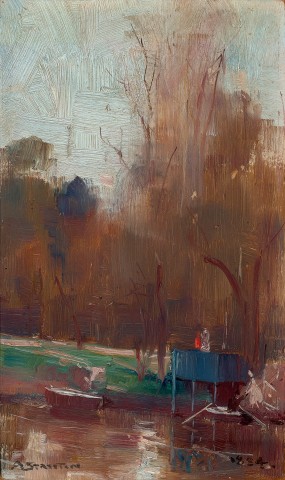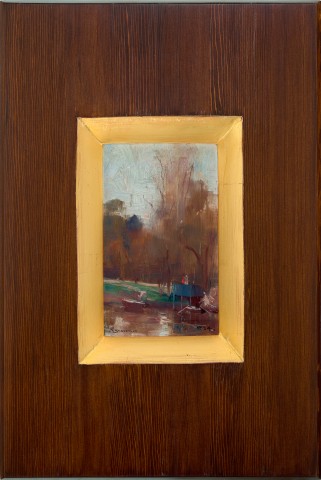BRANDER’S FERRY, 1889
ARTHUR STREETON
oil on cardboard
21.3 x 15.2 cm
signed lower left: A STREETON
dated lower right: 1884 [sic]
Madame Pfund, Melbourne, acquired from The 9 by 5 Impressionism Exhibition, by 17 August 1889
Thence by descent
Werner de Steiger, Melbourne, by 1924 (grandnephew of the above)
George Page-Cooper, Melbourne
The Historical George Page-Cooper Collection, Leonard Joel, Melbourne, 21 November 1967, lot 42 (as ’Branders Ferry on the Yarra’, 1884)
Julian Sterling, Southern Cross Galleries, Melbourne
Private collection, Melbourne, acquired from the above in 1968
Thence by descent
Private collection, Melbourne
The 9 by 5 Impressionism Exhibition, Buxton’s Rooms, Melbourne, 17 August 1889, cat. 26
Arthur Streeton Memorial Exhibition, National Gallery of Victoria, Melbourne, 5 September – 7 October 1944, cat. 24
Australian Impressionism, The Ian Potter Centre: NGV Australia at Federation Square, Melbourne, 31 March - 8 July 2008, cat. 9.38, p. 175 (illus.)
Masterpieces of Australian Impressionism, Bonhams & Goodman, Melbourne, 24 - 26 July 2009
Evening Standard, Melbourne, 17 August 1889, p. 1
’Art and Artists’, Table Talk, Melbourne, 23 August 1889, p. 4
Arthur Streeton letter to Tom Roberts, 15 April 1924, in Galbally, A. & Gray, A., (eds), Letters from Smike: the letters of Arthur Streeton 1890 - 1943, Oxford University Press, Melbourne, 1989, p. 179
Streeton, A., The Arthur Streeton Catalogue, Melbourne, 1935, cat. 63
Lane, T., Australian Impressionism, National Gallery of Victoria, Melbourne, 2007, cat. 9.38, pp. 174 (illus.), 332
250128 streeton.jpg
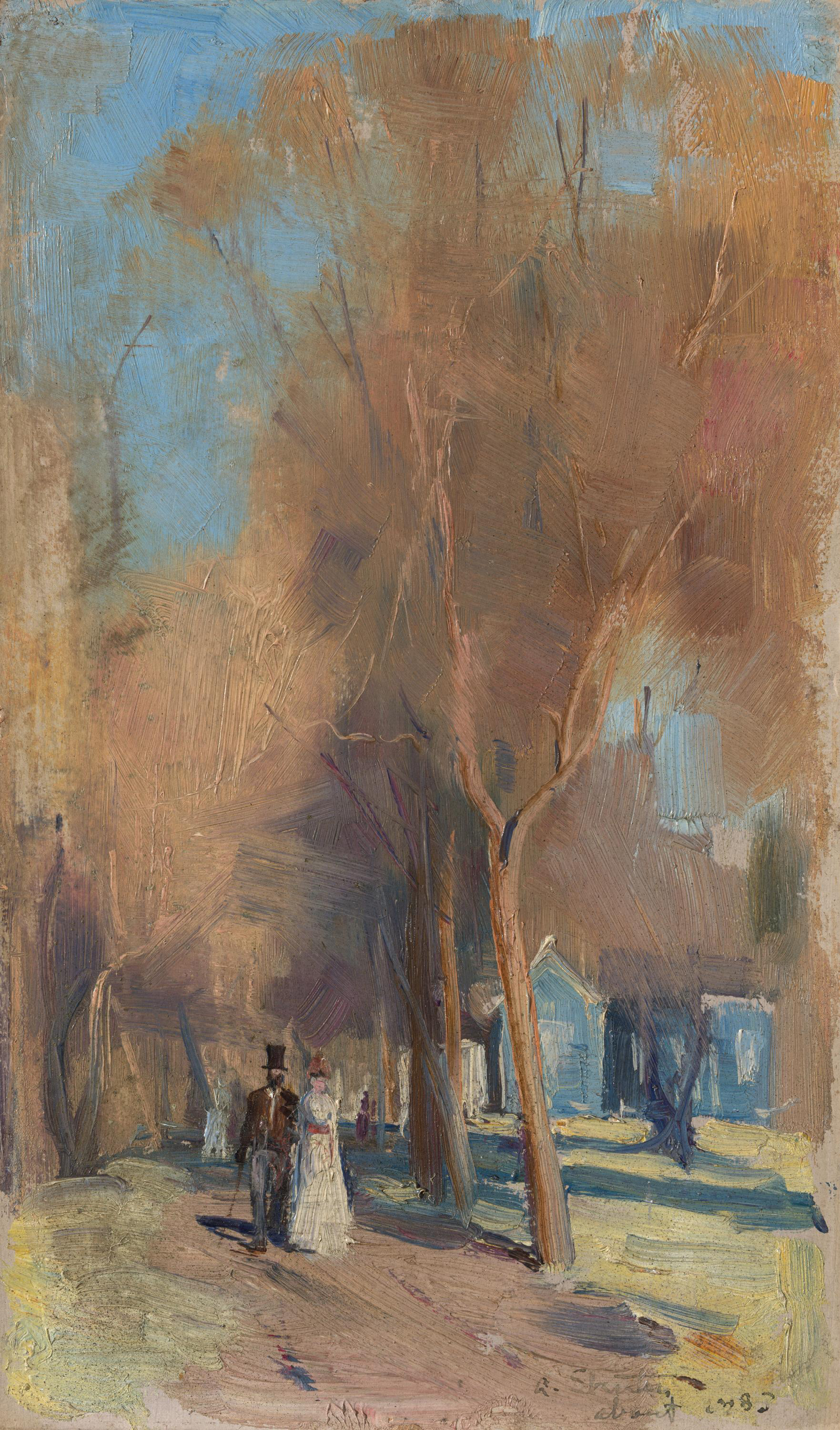
‘An effect is only momentary: so an impressionist tries to find his place. Two half-hours are never alike, and he who tries to paint the sunset on two successive evenings, must be more or less painting from memory. So, in these works, it has been the object of the artists to render faithfully, and thus obtain first records of effects widely differing, and often of very fleeting character.’1
This is how the paintings exhibited in the now famous 9 by 5 Impression Exhibition were described in the accompanying catalogue. The catalogue’s decorative cover designed by Charles Conder emphasised the deliberately provocative raison d’être of the exhibition, featuring the female personification of Art bound by the loosening ties of Convention. A landmark event in Australia’s art history, the 1889 exhibition was organised by Charles Conder, Tom Roberts and Arthur Streeton, all now major names but at the time, relatively young artists who were eager to make their mark. Conder, Roberts and Streeton were the primary exhibitors, showing 46, 62 and 41 works respectively, and were joined in the exhibition by Frederick McCubbin, C. Douglas Richardson and art students, R. E. Falls and Fred Daly, each of whom showed a smaller number of paintings.
250128 streeton-(cleaned).jpg
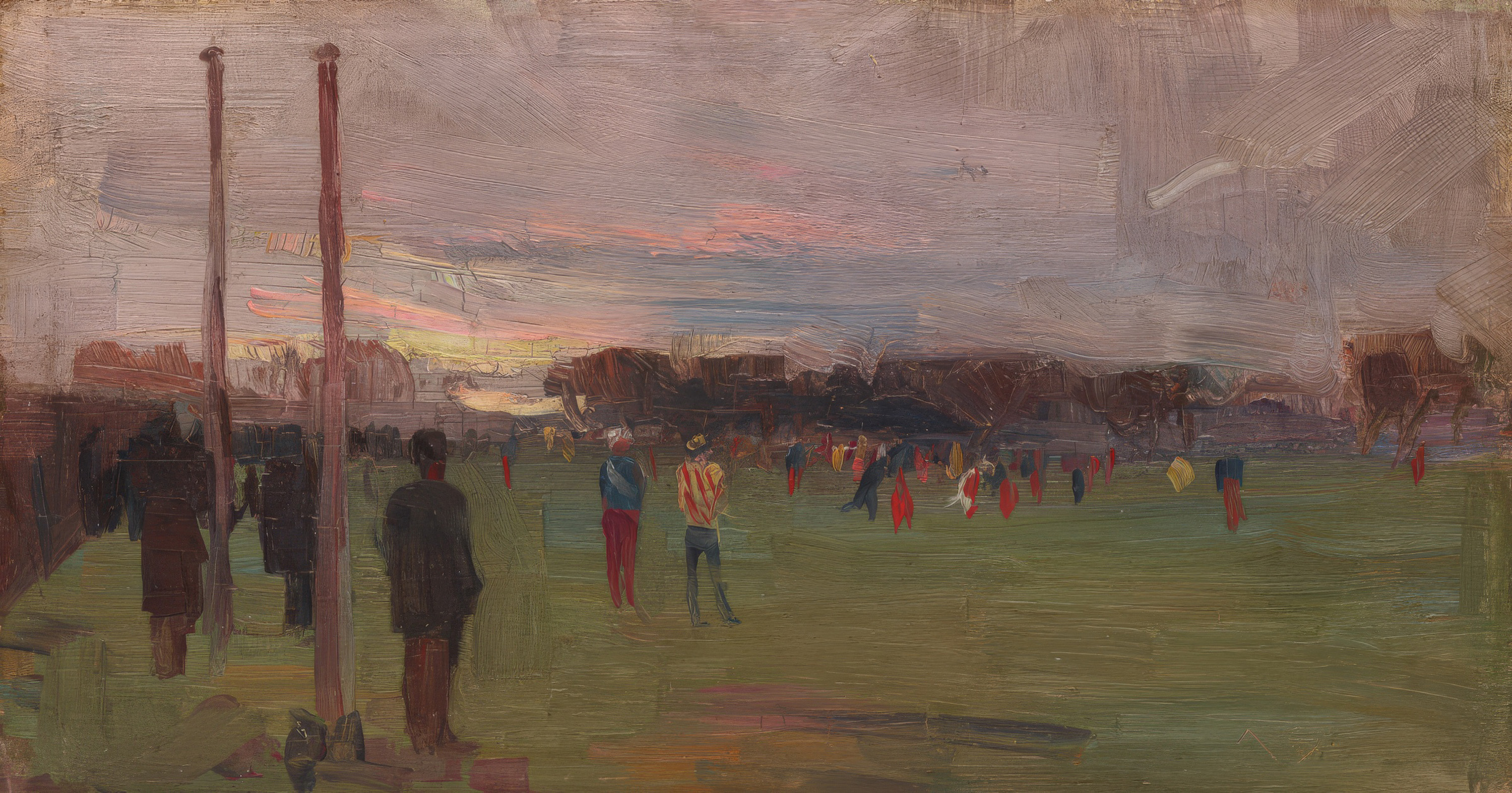
The exhibition opened in mid-August and ran for three weeks at Buxton’s Rooms in Swanston Street, opposite the Melbourne Town Hall. The gallery was ‘beautifully decorated… Drapings of soft liberty silk of many delicate colours, were drawn, knotted and looped among the sketches, while Japanese umbrellas, screens and handsome Bretby jardinieres completed a most harmonious arrangement of colour.’2 It was by all accounts quite an event: ‘great blue and green vases… were filled with japonica and roses, violets and jonquils, and the air was sweet with the perfume of daphne’3, afternoon tea was served each day and on Wednesdays, visitors to the exhibition also enjoyed musical performances.4
It was reported that ‘the general opinion was favourable… [and] in a few hours [of opening], over £50 worth of impressions was sold’5, but the exhibition also had its detractors. The now legendary response of James Smith, art critic for the Argus, was especially strong:
streeton cmyk.jpg
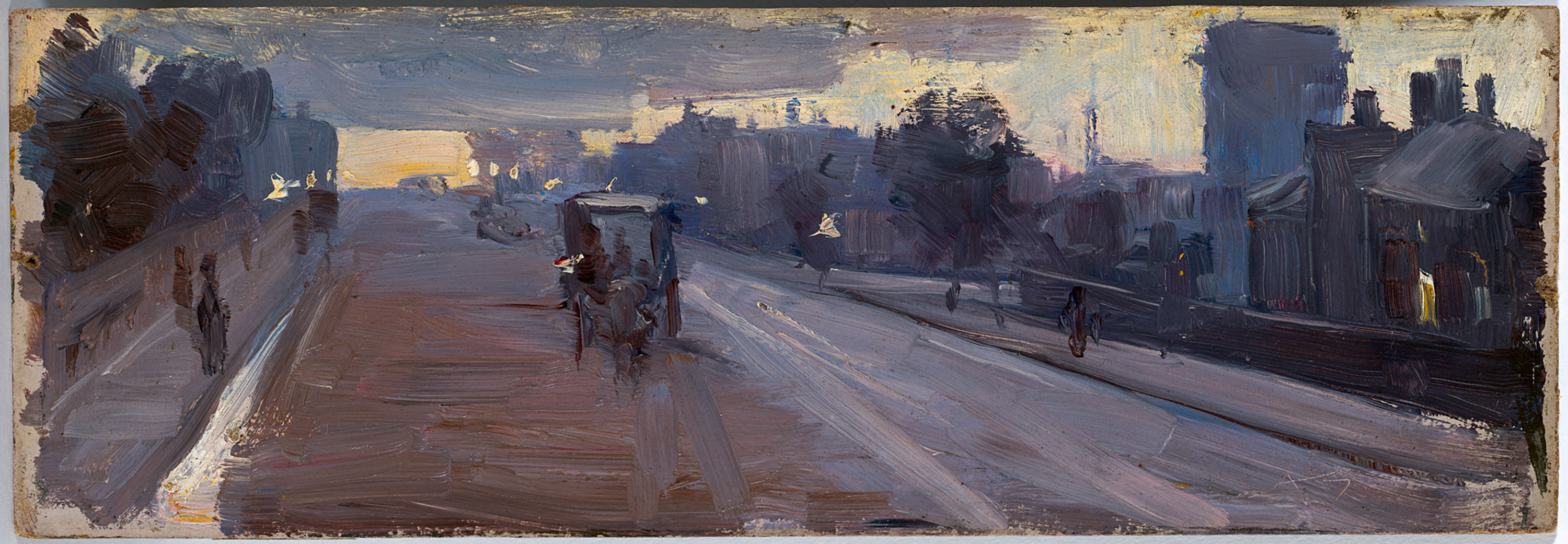
‘The modern impressionist asks you to see pictures in splashes of colour, in slap-dash brushwork, and in sleight-of-hand methods of execution… Of the 180 exhibits catalogued… something like four-fifths are a pain to the eye. Some of them look like faded pictures seen through several mediums of thick gauze; others suggest that a paint-pot has been accidentally upset over a panel nine by five inches; others resemble the first efforts of a small boy, who has just been apprenticed to a house-painter; whilst not a few are distressing as the incoherent images which float through the mind of a dyspeptic dreamer.’6
Committed to their cause, the artists displayed Smith’s review at the entrance to the gallery and argued the case in response, stating that ‘any effect of nature which moves us strongly by its beauty, whether strong or vague in its drawing, defined or indefinite in its light, rare or ordinary in colour, is worthy of our best efforts… we will do our best to put only the truth down, and only as much as we feel sure of seeing.’7 Impressionism in late nineteenth century Australia emerged in part out of the practice of painting en plein air and a rejection of academic tradition in favour of a more immediate and naturalistic approach. Small works shown in the 9 by 5 exhibition such as Streeton’s Hoddle St, 10 p.m., 1889 and Roberts’ Going home, c.1889 (both National Gallery of Australia) were quick tonal sketches that sought to capture an impression of the subject – often describing the colour and light of a particular time of day – and in this way, had more in common with the oil sketches of the American, James Abbott McNeill Whistler than Monet and the French impressionists.
250128 streeton 9x5-(cleaned).jpg
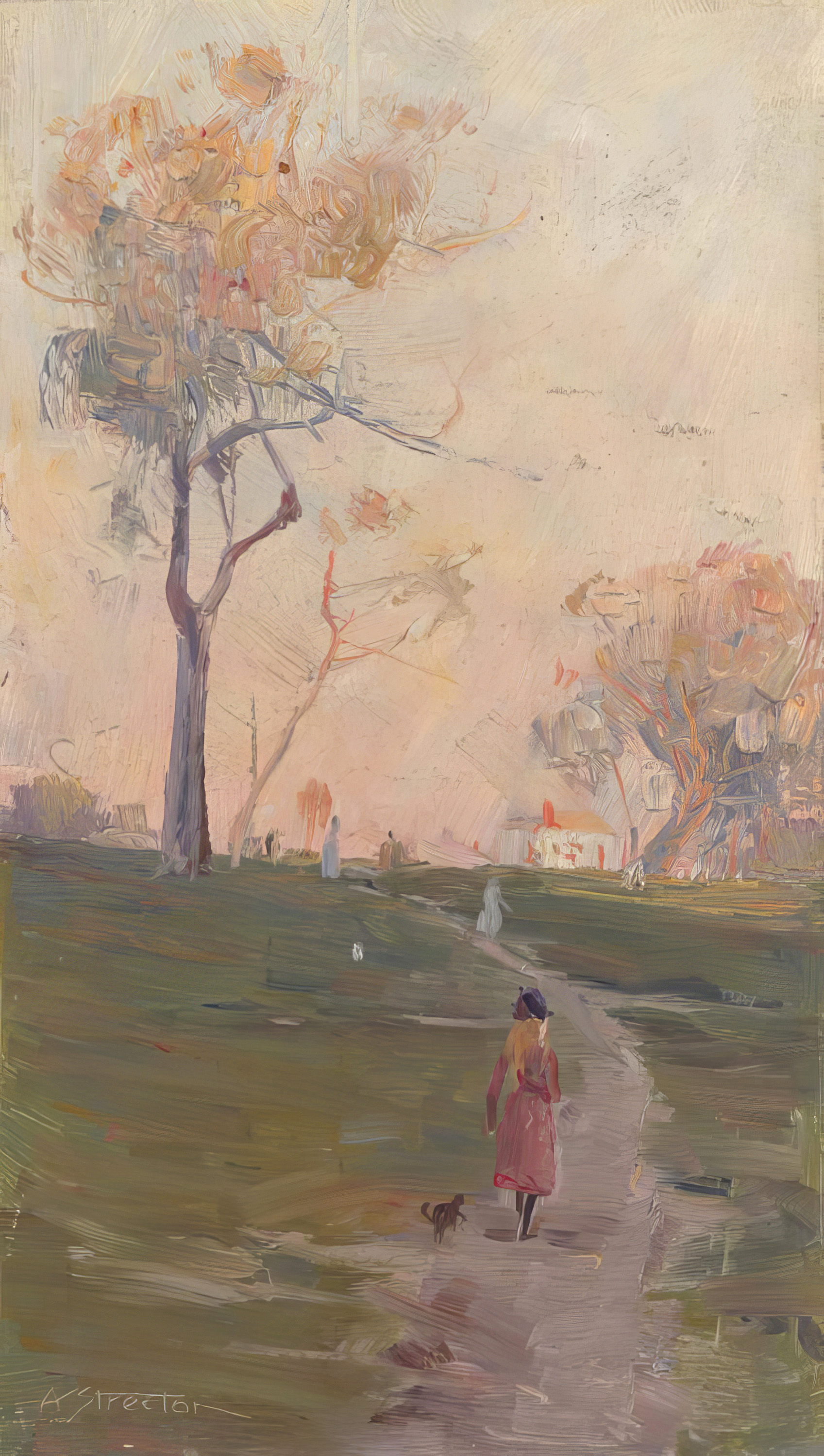
Streeton BranderesFerry wc-(cleaned).jpg
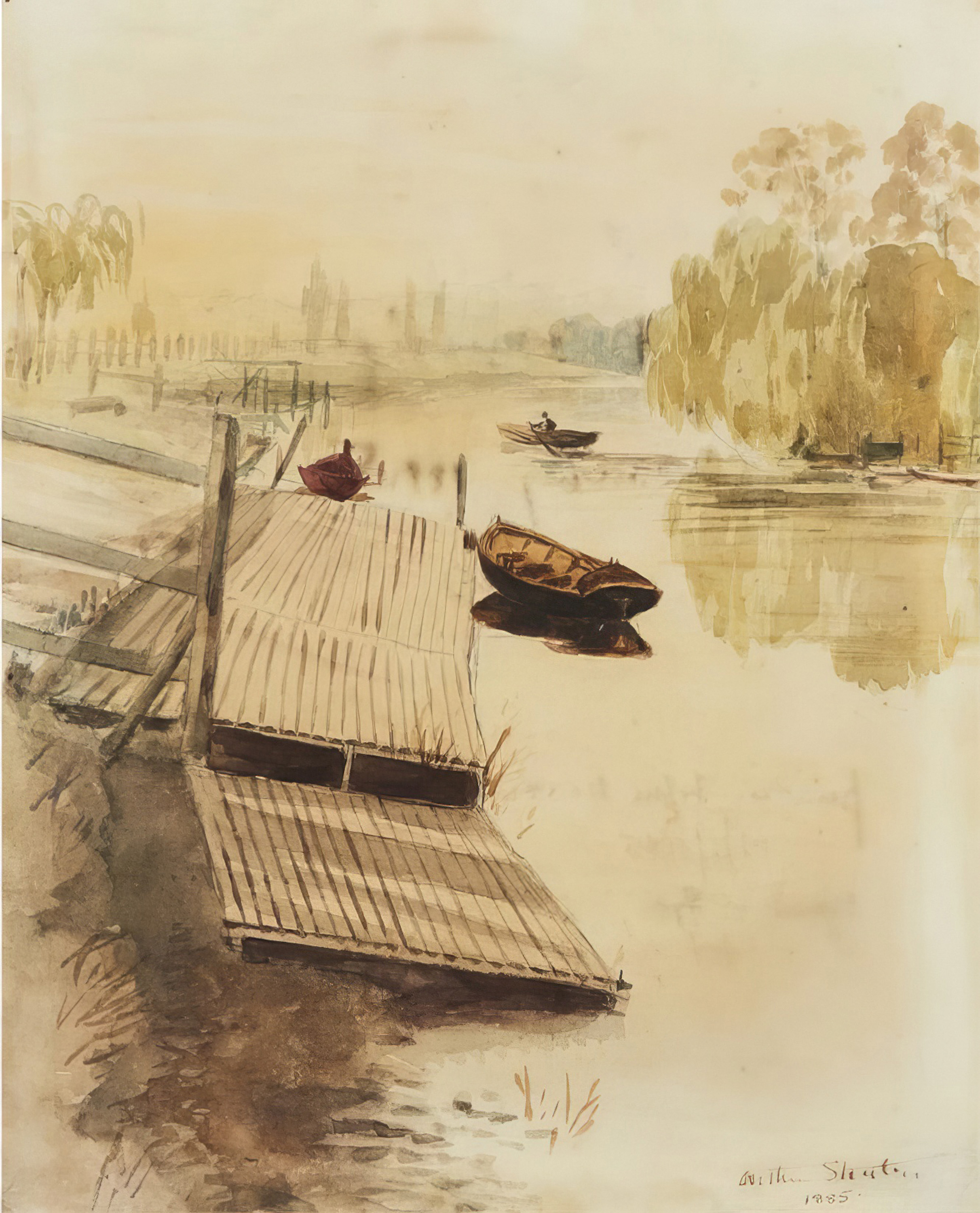
Streeton was the youngest of the organising artists, only twenty-two years of age, and many of his 9 x 5s depict Melbourne scenes, subject matter that was familiar and easily accessible: Charles Summers’ statue of Burke and Wills in Spring Street, opposite the Princess Theatre, steam ships at Sandridge (now Port Melbourne), and early evening football games, for example. Brander’s Ferry, 1889 continues this focus on the local, depicting one of the many nineteenth-century Yarra River crossing points. Developed by Michael Brander in the mid-1850s, the ferry was at the current location of the Swan Street Bridge and operated until just before the First World War. Activities at the site grew over time to include a popular tea-room and after 1876, a miniature zoo and aviary.8 As the Australasian Sketcher described it: ‘On Sundays, when the little tables… are crowded with visitors… the scene is a very pretty one. The brilliant colours of the ladies’ costumes; the quiet hum of voices; the reflections in the river which are only broken when some boating party passes; then there is the beautiful sky and the fragrant air.’9
In this 9 x 5 Streeton adopts a view across the Yarra from the south – water in the foreground leads up to a grassy bank and a path running parallel to the river, through to a band of trees in the distance. The pale sky is richly textured with visible square-edged brushstrokes and reflected in the still water below. Two figures, one in eye-catching red, stand on a raised platform to the right of the image and below them, we see a woman in a white dress taking the hand of her companion as she steps from a platform on the riverside into a rowboat. Streeton depicted Brander’s Ferry on at least one other occasion – its low timber deck was the subject of an 1885 watercolour – and, as a well-known and popular Melbourne site, it also featured in artworks by Louis Buvelot and John Mather.10
250128-(cleaned up).jpg

Brander’s Ferry has a distinguished provenance, having been purchased from the 9 by 5 exhibition by Madame Pfund, a respected member of late nineteenth-century Melbourne society who ran Oberwyl, an exclusive school for girls in St Kilda. The subject of a major portrait by Tom Roberts now in the collection of the National Gallery of Victoria, she was a friend and patron of many artists and along with this work by Streeton, bought paintings by both Roberts and Conder from the exhibition.11 Her nephew, Werner de Stieger, inherited the painting and we know from correspondence from Streeton to his fellow artist friend Tom Roberts that in 1924 de Stieger asked Streeton to sign it.12 That it was inscribed more than thirty years later accounts for Streeton incorrectly recalling the date which he gives as 1884 instead of 1889.
1. Statement from the catalogue of the 9 by 5 Impression Exhibition, Melbourne, 1889, title page
2. Table Talk, 23 August 1889, cited in Lane, T., ‘The 9 by 5 Impression Exhibition – The Challenge of the Sketch’ in Lane, T., Australian Impressionism, National Gallery of Victoria, Melbourne, 2007, p. 162
3. Daily Telegraph, Melbourne, 24 August 1889, p. 10
4. Lane, op. cit.
5. Evening Standard, 17 August 1889, p. 1
6. The Argus, Melbourne, 17 August 1889, p. 10
7. The Argus, Melbourne, 3 September 1889, p. 7
8. See Jones, C., Ferries on the Yarra, Greenhouse, Collingwood, 1981, p. 15 and https://www.rowinghistory-aus.info/club-histories/mercantile/01-3#gsc.tab=0 (accessed 31 March 2025)
9. Australasian Sketcher, 17 January 1883, cited in Jones, ibid., p. 16
10. Louis Buvelot, Ferry on the Yarra (Brander’s Ferry), undated, oil on board, 20 x 30.5 cm, sold Sotheby’s, Melbourne, 26 November 2002, lot 96; John Mather, Brander’s Ferry, 1894, etching, 13.2 x 9.6 cm, National Gallery of Australia; and Arthur Streeton, Branders Ferry, Morning Yarra, 1885, watercolour, 23.5 x 19 cm, sold Shapiro Auctioneers, Sydney, 22 November 2017, lot 100
11. See Lane, T., Nineteenth-Century Australian Art in the National Gallery of Victoria, National Gallery of Victoria, Melbourne, 2003, p. 91
12. Streeton to Tom Roberts, 15 April 1924, in Galbally, A. and Gray, A. (eds.), Letters from Smike: The Letters of Arthur Streeton 1890 – 1943, Oxford University Press, Melbourne, 1989, p. 179
KIRSTY GRANT
